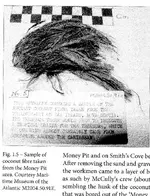lokiblossom
Bronze Member
- Joined
- Dec 4, 2014
- Messages
- 1,865
- Reaction score
- 1,310
- Golden Thread
- 0
- Location
- Traverse City, Mi.
- Primary Interest:
- Relic Hunting
- #1
Thread Owner
www.ccriindia.org/pdf/02Historyofcoirindustry.pdf
www.oakislandtreasure.co.uk/research-documents/discoveries/coconut-fibre/
Of these reports the Richard C. Nieman "letter to Oak Island Investors" of October 6, 1993 is quite telling. But, the paper dated September 30, 1993 (two pages) takes into account the adjustment for dendro calibration, giving a final maximum's dating of the fibre from 1036-1298 or as on the report page approx. 1229 AD.
After reading the above reports its quite obvious that during the time period indicated by the C-14 dating the only source for Europeans to obtain coconut fibre (coir) would be through contact with Arabic countries of the Middle East (or Western Mediterranean) region sometime between 1036-1298 (a maximum range) or closer to 1229 AD.
www.oakislandtreasure.co.uk/research-documents/discoveries/coconut-fibre/
Of these reports the Richard C. Nieman "letter to Oak Island Investors" of October 6, 1993 is quite telling. But, the paper dated September 30, 1993 (two pages) takes into account the adjustment for dendro calibration, giving a final maximum's dating of the fibre from 1036-1298 or as on the report page approx. 1229 AD.
After reading the above reports its quite obvious that during the time period indicated by the C-14 dating the only source for Europeans to obtain coconut fibre (coir) would be through contact with Arabic countries of the Middle East (or Western Mediterranean) region sometime between 1036-1298 (a maximum range) or closer to 1229 AD.
Last edited:




